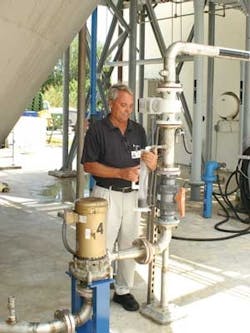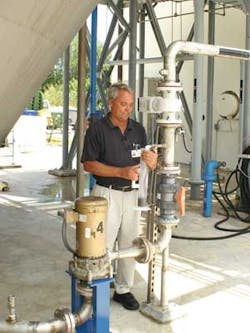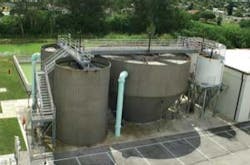Ion Exchange System Helps Remove DOC, Limit DBPs
By Steve Gibbs
It is perfectly understandable if public works and utility directors get a bit nervous when they consider the EPA's Stage 2 Disinfectants and Disinfection Byproducts Rule (Stage 2 DPBR).
The Stage 2 DPBR, which governs the levels of total trihalomethanes (TTHM) and five haloacetic acids (HAA5) in drinking water, were promulgated in 2006 with compliance monitoring beginning in 2012. The new, stricter guidelines require compliance for those treatment byproducts at all points in the distribution system compared with the current standard where compliance is based on the average levels across all sampling points. In order to comply with the new regulations, some water utilities may have to scrap and rebuild perfectly good treatment facilities at a cost of millions of dollars.
Don Ray, superintendent of water treatment plants for the Village of Palm Springs, sampling settled MIEX resin.
In Florida, the Village of Palm Springs, with a utility service area population of 43,000, has already addressed the issue and is in compliance with the Stage 2 rules. In fact, their water quality, which was once very poor, is now considered among the very best in America. They achieved all this four years ago by implementing what was then a first-of-its-kind technology in America. Their success has led the way for at least a dozen other municipalities to follow.
"Our finished water used to have high color. It contained a lot of organics and minerals, and we received complaints all the time," said Bill Davis, Public Service Director for the Village of Palm Springs. "About four years ago we installed the MIEX system as a DBP precursor removal water treatment process. The water that comes out of our plant now looks and tastes better than most bottled water."
Just how good is the water in the Village of Palm Springs? In 2009 it was selected as the best tasting drinking water in Florida and finished in the top five when compared to water from across the country at the American Water Works Association Annual Conference and Exposition (ACE 2009) in San Diego. The Village's water also was selected as the best tasting water in Florida by the Florida Rural Water Association. What's more, the TTHM and HAA5 levels are now each less than 20 micrograms per liter, well below the new Stage 2 DBPR standards for drinking water.
Treatment System
The turnabout in the Village's water quality came in 2005 when their MIEX (Magnetic Ion Exchange) system from Orica Watercare went on line. The technology is simple yet effective in removing the dissolved organic carbon (DOC) that is abundant in Florida's surface and groundwater supply. MIEX, which was developed by Australia-based Orica Watercare, was at the time a mostly unknown and unproven process in the U.S. As an unknown, many civil engineers and public works directors were reluctant to try it.
"I first heard about MIEX at the 2002 WEFTEC show in Chicago from John Mushinsky of Moss-Kelley, Inc., which is Orica Watercare's representative in Florida," said Doug Hammann, P.E., of Eckler Engineering. Hammann is the consultant to the Village of Palm Springs. "We did some bench scale tests and liked the results, so we arranged a pilot test on site. The pilot testing proved that the technology could meet the project design goals, so we felt confident going forward with the project."
Although the Village of Palm Springs' two treatment plants were well maintained and relatively modern, they were not designed to remove the amount of DOC present in South Florida's raw groundwater supply. Even after chlorination, the high DOC content resulted in ugly, bad-tasting water along with relatively high levels of TTHM and HAA5. With Stage 2 DBPR deadlines on the horizon, the Village faced the possibility of two extensive treatment facility upgrades in order to be in compliance.
"They didn't want to spend $20 to $30 million to upgrade their treatment facilities when their lime softening process worked just fine," Hammann said. "They just had a precursor issue; they needed to remove the precursor, the high levels of DOC in the water. The MIEX system could be installed at the head of the plant and accomplish that purpose. Everything downstream from that point would remain the same."
Removing DOC
The MIEX technology solves the disinfection byproduct problem by removing most of the DOC from the groundwater before it enters the existing treatment processes. Disinfection byproducts such as TTHM and HAA5 resulting from chlorination treatment are greatly reduced because there is far less DOC in the water to react with the chlorine.
Raw water passes in series through the two contactor vessels (left) where the ion exchange takes place. The resin and water then pass to the settling basin, where the resin settles out and treated water overflows to softening treatment downstream. Most of the settled resin is recycled back to the contactor vessels while a small sidestream is sent to the regeneration vessels (right) for regeneration before being returned to the contactors.
"It's a simple process that meets a need," Mushinsky said. "It's an anion exchange technology. DOC is made up primarily of negatively charged particles. When the MIEX resin contacts raw water, it grabs the negatively charged DOC particles and exchanges it for a chloride ion."
The magnetic properties of the resin beads form agglomerates with the accumulated DOC which rapidly settle and are removed from the water stream. A small stream of the agglomerates are removed from the settler tank and sent to a regeneration tank filled with a 12 percent solution of sodium chloride or other salts, such as sodium bicarbonate. The regenerated resin is returned to the reactor vessel to maintain consistent ion exchange capacity. The small amount of waste fluid from the brine tank is discharged for disposal, sometimes to the sewer treatment facility.
"MIEX produces a smaller waste stream than other methods," Mushinsky said. "About one-tenth of one percent of treated water is lost to waste with MIEX, compared to 15 percent or more with other technologies."
The system is also efficient, he said, removing 75-80 percent of DOC from raw water, yet it consumes about 98 percent less electricity than other technologies. Furthermore, the system requires less capital expenditure to install and maintain than most other precursor treatments, and can be configured to fit a small footprint.
"At larger plants, footprint becomes a very important issue," said Michael Bourke, vice president for marketing at Orica. "We're designing systems for large metropolitan plants that process more than 100 million gallons per day. These plants have very little available space. Fortunately, the technology is flexible enough that we can fit a MIEX system even in a very small area."
Leading by Example
The success of the process in the Village of Palm Springs has encouraged other municipalities to explore the technology for their own use. Since 2005 there have been 17 public utilities across the country install MIEX systems, including six in Florida. Many of them came to the Village of Palm Springs before making their decision.
"We've recommended the MIEX system to other public works officials and engineers many times over the past few years," said Don Ray, superintendent of water treatment plants for the Village of Palm Springs. "The system is very effective and very user friendly." WW
About the Author:
Steve Gibbs is a freelance writer based in Memphis, TN, with 20 years of experience covering public works and construction projects for regional and national publications.
More WaterWorld Current Issue Articles
More WaterWorld Archives Issue Articles


